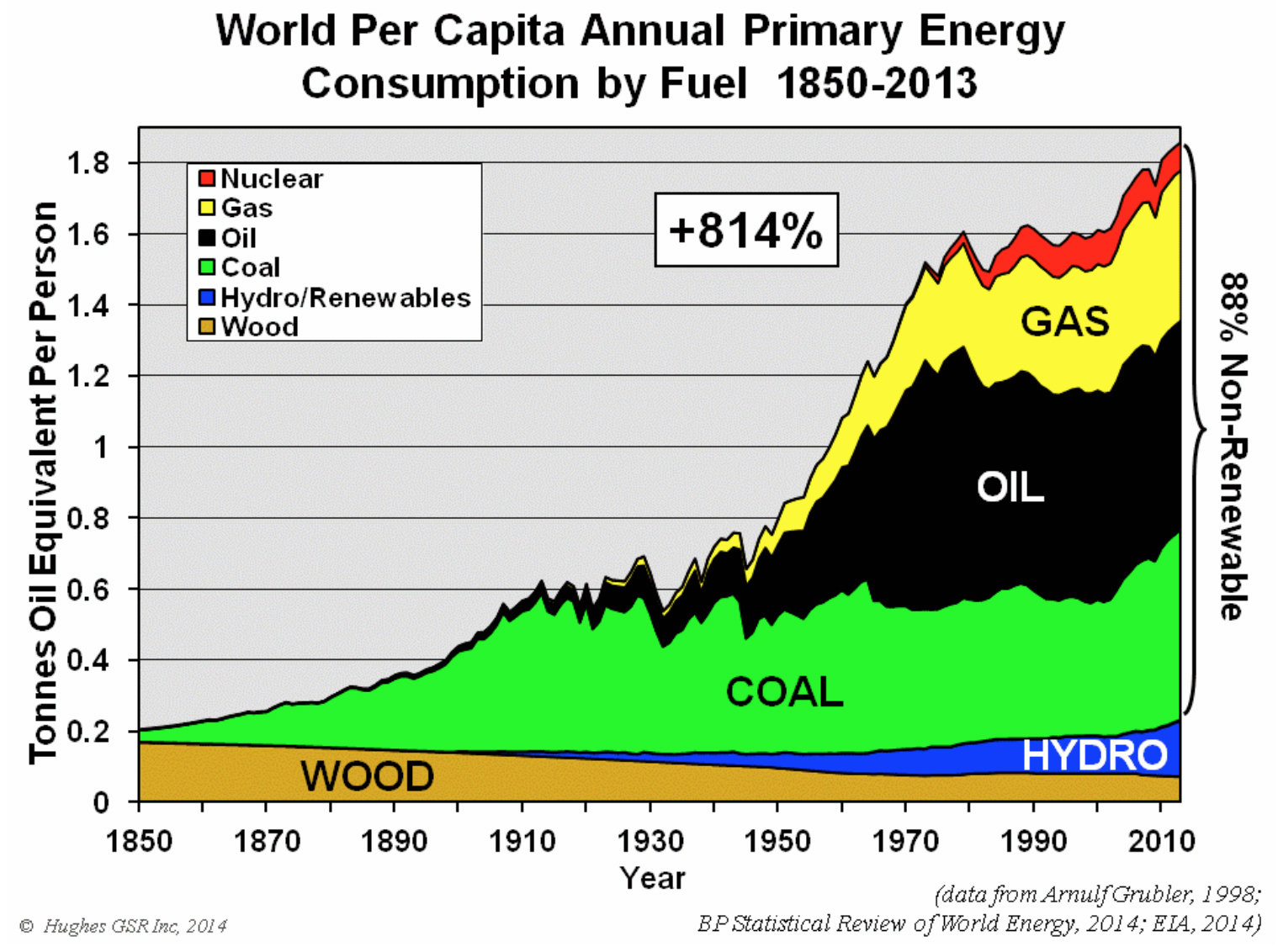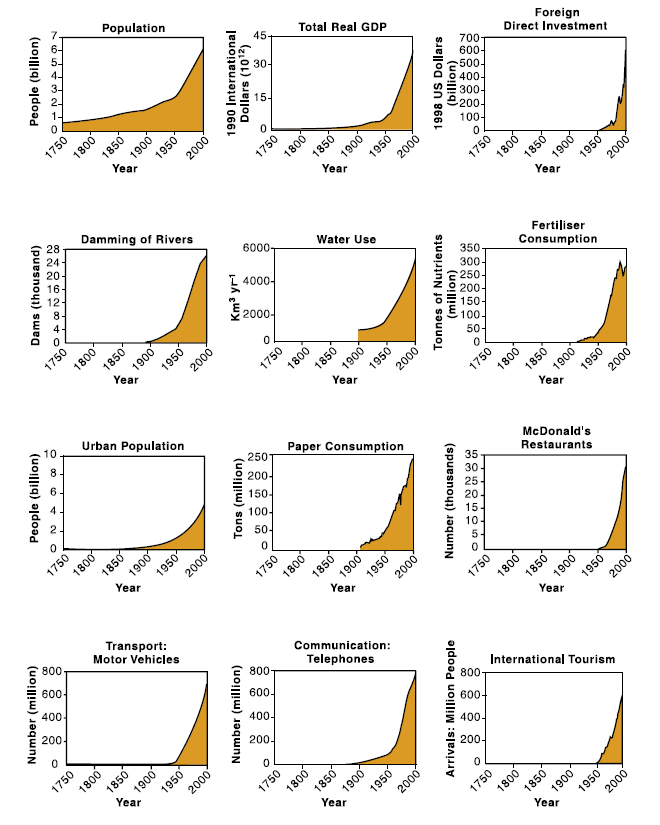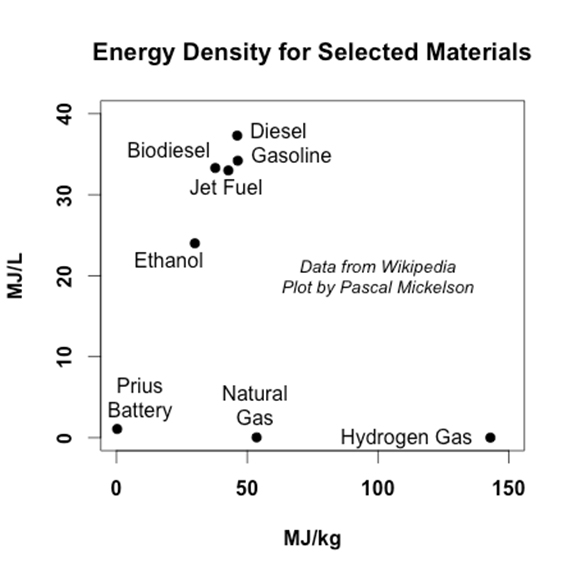The current challenge
Inge Røpke
The analysis of human history from an energy perspective makes it possible to understand the nature of the most fundamental current challenge: Humanity is in the process of finding a new energy base, and we are in the middle of a radical transformation into a fourth phase in our energy history, a new socio-ecological regime. It involves a far more radical change than any that occurred in the development of different versions of capitalism and planned economies. The size of the challenge is illustrated in the figure below, which shows that the world’s energy supply is still predominantly based on fossil fuels. In Denmark, fossil fuels also play a significant role in total energy consumption, although renewable energy sources make a major contribution to electricity production.

As a result of the use of fossil fuels, humanity has had such an impact on nature that the changes can be measured on a geological scale. Firstly, the emission of carbon into the atmosphere has intensified the greenhouse effect and contributed to a gradual increase in temperatures, acidification of the oceans, an increase in water levels, etc. – and it will do so much more in the future. Secondly, the availability of cheap energy has made it possible to influence the flow of materials so much that it exceeds the previously naturally occurring movements, resulting in significant environmental problems. Thirdly, the growth in population and living standards have led to the appropriation of an increasing amount of land and freshwater for human purposes, which has resulted in a severe decrease in biodiversity. This development has especially been occurring since the end of World War II, which is referred to as ‘the great acceleration’: All curves point upwards.

The changes are so significant that geologists are discussing whether we have already moved out of the Holocene and into a new geological epoch that may be called the Anthropocene because of the role human activity has played in the change. Since the conditions in the Holocene epoch have been particularly favourable for humans, there are good reasons to try to avoid the changes heralded by the Anthropocene epoch.
Environmental problems are multifarious and call for different strategies – chemical regulation, the recycling of materials, the reestablishment of ecosystems, etc., but the renewal of the energy base is the most fundamental.
A new energy base
The use of fossil fuels hits a limit into two ways. In the past, there has been a focus on the potential for a lack of fuel. Up to now, this problem has manifested itself by the fact that reserves are becoming increasingly difficult to get hold of because one, of course, starts to extract the most available resources first. Gradually, it takes more and more energy to extract energy, so the net surplus gets smaller. This applies to the extraction of both oil and gas from fields in the sea, the extraction of oil from tar sands, oil and gas from fracking and the extraction of coal from mines where the coal is harder to obtain or is of poorer quality. The concept EROI – Energy Return On (energy) Input – is used to put a figure on this development: During the early phase of oil extraction, which focused on the most easily retrieved oil sources, it was possible to get 100 barrels of oil from using 1 barrel of oil in the extraction process, i.e. EROI was 100. When oil is being extracted from the sea, EROI is often as low as 10. EROI is often measured in relation to the energy input needed for the actual extraction, but energy is also used during the subsequent refining process and transportation to consumers, as well as the more indirect energy consumption connected with the construction of the necessary infrastructure in the form of, for example, roads, cars, petrol stations, car parks, etc. This means that EROI during extraction has to be relatively high to ensure that the society functions.
The other limit is related to carbon emissions. In 2012, the IEA (International Energy Agency) concluded that two-thirds of the known reserves of fossil fuels must remain unused if the increase in temperature is to be kept under 2 degrees. Recent studies have adjusted this figure to three-quarters, but in any case, it seems that not using the reserves is a much bigger challenge than the fact they are scarcer and harder to obtain than previously. Some hope that we can continue to use fossil fuels by using methods to collect the carbon emissions and storing them, such as Carbon Capture and Storage (CCS), but the technology is still at the developmental stage, and the use will exacerbate the problem of decreasing EROI. However, the alternatives to fossil fuels are also associated with problems, while the transition itself is very demanding.
[otw_shortcode_info_box border_type=”bordered” border_style=”bordered”]Challenges for an energy transition
- Technologies that can exploit renewable energy sources with sufficiently high EROI must be developed.
- Some of the energy sources should preferably (like fossil fuels) have a high energy density, i.e. the amount of energy per weight unit, and be mobile so that they can be used for example in airplanes. In addition, there is a challenge in developing alternatives that can compete with the high energy content per volume of fossil fuels. This is, for example, a challenge for battery technologies, which still can not compete with fossil fuels in this area (see figure: energy density for selected materials).
- Systems where the energy sources support each other must be developed. The systems will be different in different areas, depending on the resources that are available. For example, solar and wind resources are very unevenly distributed.
- Energy needs to be stored because renewable energy sources, such as sun and wind, are erratic.
- Investments in infrastructure that make it possible to exploit energy sources must be made.
- The use of biomass as an energy source must be limited because it competes with land use for food production and the maintenance of biodiversity.
- Solutions must be sought to environmental and social problems that are linked to the alternative sources of energy, e.g. the problems associated with the extraction of minerals for batteries and electronics, or the environmental and safety issues associated with nuclear power.
[/otw_shortcode_info_box]

http://www.postcarbon.org/our-renewable-future-essay/
A particular challenge is that the transition itself is energy-intensive. The concept energy cannibalism (originally used in connection with nuclear power) refers to a situation where so much energy is used in the expansion of renewable energy that it surpasses the amount of energy contributed by the renewable energy sources. This, of course, only applies to the period where renewable energy is expanding rapidly, but it makes it difficult to replace fossil fuels sufficiently quickly, especially if you imagine that everyone should also have an even higher standard of living.